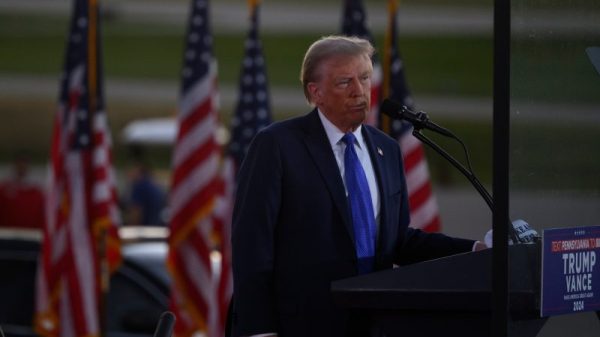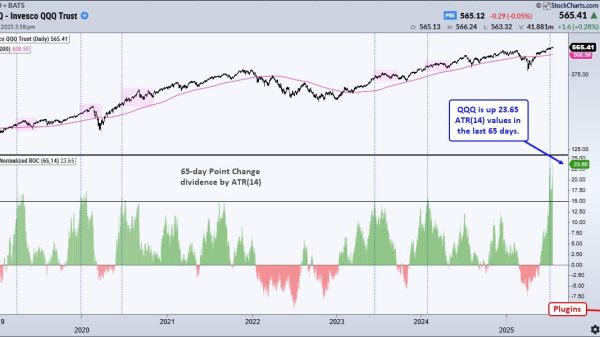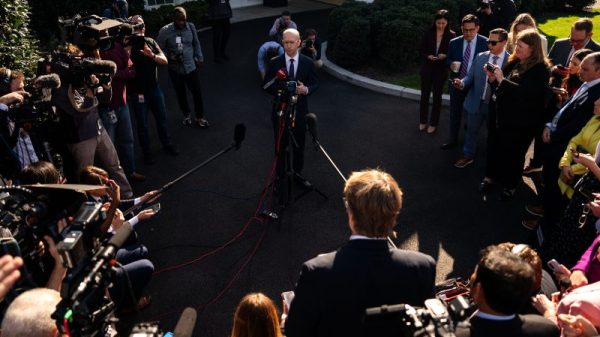College football teams score less often from the 1-yard line using the shotgun formation compared to under-center plays.
Despite lower success rates, the shotgun is used more frequently than under-center plays at the 1-yard line.
Coaches cite fear of fumbled snaps as a reason for favoring the shotgun, despite data showing no fumbles on under-center snaps from the 1-yard line in the study.
The shotgun formation leads to more negative-yardage plays and penalties near the goal line.
Midway through the second quarter of Alabama’s 2023 home defeat of Mississippi, Ja’Corey Brooks blocked a punt that gave the Crimson Tide offense a first-and-goal from the Rebels 1-yard line. But instead of plowing ahead with a quarterback sneak or calling for a running back to plunge over the top, Alabama took a loss of 13 yards when an errant shotgun snap got away from Jalen Milroe, and Alabama was forced to kick a field goal. Two days later, legendary coach Nick Saban was asked whether the shotgun formation was a wise alignment in that situation.
‘It was not smart on our part to do what we did, and we get a bad snap after all that,’ Saban said. ‘… I agree with you that, at a time when it’s first-and-goal on the 1, why do we need to be in shotgun?’
A more profound question: from the opponent’s goal line, why would any offensive coordinator ever employ the shotgun?
PATH TO PLAYOFF: Sign up for our college football newsletter
USA TODAY Sports reviewed every goal-line offensive play last season for 15 of the top programs in college football, spanning all four power conferences, and found that the shotgun formation resulted in significantly fewer touchdowns than plays called with the quarterback taking the snap from under center. From the opponent’s 1-yard line, those teams scored on just 56% of shotgun snaps, compared to a 73% touchdown rate from under center. Yet despite that disparity, offensive coordinators called the shotgun formation more often: 90 shotgun looks versus 72.
Teams researched were Alabama, Arizona State, Boise State, Clemson, Georgia, Indiana, LSU, Miami, Michigan, Missouri, Nebraska, Notre Dame, Ole Miss, Penn State and Texas. And while 15 is a far cry from the entirety of 134 FBS schools that played last year, it is a strong representation of the sport’s elite. Twelve of the 15 made the College Football Playoff’s final rankings, and eight qualified for the 12-team playoff field.
David Cutcliffe, for one, was unsurprised by the findings.
Across a 40-year coaching career from 1982-2021 at Tennessee, Ole Miss and Duke, Cutcliffe witnessed under-center play lose its grip as the foundation of college offenses everywhere, slowly giving way to the shotgun formation as the modern play-starter. Cutcliffe noted that the shotgun has so overtaken the sport that most quarterbacks know nothing else at the youth level, particularly with the proliferation of 7-on-7 passing tournaments. Meanwhile, in the coaching profession, there is a progressively shrinking understanding of how to teach under-center play. An entire generation of coaches grew up on the shotgun, and many view under-center play as little more than a relic.
‘It’s easy to sit in the nickel seat I’m in now and sound like I’m criticizing coaches − I’m not. Because I’d tell any of them, ‘Teach what you know’. If you don’t know it, you can’t just look at a film and say, ‘Let’s do this,” Cutcliffe said. ‘At the same time, I’m not sure that offensive coordinators as a group fully understand all the idiosyncrasies of under-center goal-line offense anymore. It’s taught at some places. It’s not taught everywhere.’
Shotgun formation is 5-yard giveaway
The fundamental argument against the shotgun formation at the goal line is simple enough: the snap moves the ball from the 1-yard line to the 6-yard line to begin the play, even more if a pass is called and the quarterback retreats another step or two.
That gives defensive penetration a better opportunity to not only prevent a score but make a stop for negative yardage, whereas defenses have no such advantage in defending a direct run from under center. The benefits of operating from the shotgun make for a different calculation elsewhere on the field. But on the goal line, with seven points staked on a very short gain, old-school football delivers more touchdowns and settles for fewer field goals than the shotgun.
Just ask defensive coordinators what they’d rather face.
‘I love for the quarterback to be 5 yards deeper taking the snap,’ said Indiana defensive coordinator Bryant Haines. ‘As a defense, we’re fighting for every single inch in that area of the field. The deeper I can get him, the further away from the center, that play is better for me.’
Illustrating the point last season were some very high-profile goal-line failures from the shotgun. Most notable among them came in Texas’ loss to Ohio State in a College Football Playoff semifinal. The Longhorns were on the Buckeyes 1-yard line with 3:16 remaining, a yard away from tying the score at 21. On second-and-goal, Texas ran a sweep from a shotgun formation that was smothered for a 7-yard loss. Two plays later, Ohio State linebacker Jack Sawyer sacked Quinn Ewers and returned a fumble 83 yards for a game-clinching score in a 28-14 win.
Texas benefitted from shotgun madness just two weeks earlier in its first-round playoff win over Clemson. The Tigers blew two fourth-quarter shots from the Texas 1-yard line with back-to-back shotgun calls. Results: run for no gain, run for a loss of 1, turnover on downs.
College football coordinators scared to go under center
So why are offensive coordinators so shotgun-stubborn at the goal line? Because they’re scared to go under center.
Multiple coaches cited the risk of a fumbled snap exchange as the reason they remain beholden to the shotgun. With freshman centers and quarterbacks entering college largely untrained in the under-center exchange, and offensive coordinators dedicating most practice reps to the shotgun, fumbles on under-center snaps can be commonplace in practice. And what coaches see in practice shapes game plans.
One head coach said the under-center exchange, especially in spring practice, can be ‘a disaster.’ But is it such a big risk that play callers should abandon the under-center plays that scored 17% more often than the shotgun? When it comes to fumbles, the data says they shouldn’t be so fearful of putting their quarterbacks under center. In 72 under-center snaps from the 1-yard line last year, the 15 teams examined by USA TODAY Sports didn’t fumble once.
Alabama coach Kalen DeBoer agreed that practice fumbles can deter play-callers away from going under center on Saturdays. While neither Alabama nor any other team researched by USA TODAY Sports fumbled from the 1-yard line, the Crimson Tide lost an under-center fumble from the 2-yard line against South Florida last September. DeBoer said that while Alabama became more comfortable operating from under center over the course of his first season at the the school, that turnover ‘remained fresh in our minds.’
Still, however frequent under-center fumbles might’ve been in practice, they didn’t manifest on Saturdays. The shotgun not only failed to provide better ball security in game action, it also resulted in more negative-yardage plays, as well as a disproportionately high number of penalties: 14 from the 3-yard line or closer, while there was only one penalty from under center. And that’s no coincidence, either.
‘The shotgun is more risky for false starts at the goal line,’ Cutcliffe said. ‘Everything is closer. The DBs are closer. The fans are closer, the noise is closer. It’s already a very difficult time to communicate, and when the quarterback backs up 5 yards, it’s that much more difficult for him to be heard.’
And that much more difficult to score.
Old-school approach at Arizona State
While most of the 15 schools showed a propensity for sticking with the shotgun from the goal line, there were exceptions. Arizona State was under center for 11 of 12 snaps from the opponent’s 1-yard line. And while the powerful style of All-America running back Cam Skattebo might’ve made that more sensible, Skattebo’s short-yardage effectiveness wasn’t the only reason. Sun Devils offensive coordinator Marcus Arroyo believes in under-center play like few others.
He said the quarterback is under center on about half of the team’s run-game reps in practice, much more than most.
‘It’s about your identity on offense as a whole. Do you believe in under-center play? If you don’t, you’re not going to practice it. We believe in it. I’m from a pro tree, not a spread tree,’ Arroyo said. ‘If I’m on the 1-yard line, we’re under center with direct runs. But at the same time, I can understand coaches who don’t practice it saying, ‘Wait, we practice this three snaps a day, we’re not going to run it on the most expensive part of the field.”
USA TODAY’s research extended to the 2- and 3-yard lines as well. From the 2-yard line, plays from under center and the shotgun converted a touchdown at the same rate, 57%. From the 3, the shotgun was more effective (44% vs. 35.7%), although in the aggregate of all three distances, under-center calls scored more often (61.7%) than shotgun calls (51%).
What stood out in research from the 2- and 3-yard lines was a more staunch unwillingness by play-callers to go under center. From the 2, teams ran 93 snaps from shotgun and just 28 under center. From the 3, inclusive of 2-point conversion attempts, the disparity was 150 to 28.
But the shotgun price was paid from the longer distances, too.
In Penn State’s 20-13 loss to Ohio State, the Nittany Lions had a first-and-goal from the Buckeyes’ 3-yard line, ran four consecutive plays from the shotgun, and failed to punch in what would’ve been a game-tying score. For the season, including 2-point tries, Penn State ran 13 plays from the 3-yard line, all from the shotgun, and failed to score on 12 of them.
Play-action Peyton Manning
Displayed in Cutcliffe’s home is a framed photo of Peyton Manning crossing the goal line with an easy 1-yard touchdown run on a naked bootleg in Tennessee’s 41-14 win over rival Alabama in 1995.
For Cutcliffe, the play illustrates another key weakness of the shotgun formation: the play-action fake. From the shotgun, run fakes are perfunctory at best; defenses never lose sight of the ball and linebackers aren’t fooled, leaving them in better position to defend a pass. From under center, a well-executed fake hides the ball from the view of the defense, compelling linebackers to crash gaps to stop the run, which opens passing lanes.
The story behind Cutcliffe’s photo, however, is priceless.
On the team bus en route to Birmingham’s Legion Field to play Alabama, Cutcliffe sat beside Manning and hatched an idea for a goal-line, play-action fake that would fool not only the Crimson Tide but the Volunteers as well. Cutcliffe told Manning that if Tennessee found itself on the 1-yard line, he would call an under-center play known as 2-power, on which running back Jay Graham would take a handoff and leap over the top for the score.
But only Cutcliffe and Manning knew it would be faked.
‘I didn’t even tell our coaches,’ Cutcliffe said. ‘I told Peyton to call 2-power in the huddle, put that ball right in his belly, pull it out and take the bootleg to the weak side. I said, ‘Trust me on this, you’ll walk into the end zone.”
Manning indeed scored with ease as the Crimson Tide defense sold out to stop Graham. In Cutcliffe’s photo, Manning is crossing the goal line with no defender within 10 yards of him. In the background, offensive lineman Jason Layman, thinking Graham had the ball, has his arms raised to signal touchdown while watching the running back land in the end zone.
‘Rarely do you get to call your shot on the bus on the way to the stadium, but it happened exactly like that,’ Cutcliffe said.
Manning signed the photo with the inscription: ‘Coach Cut, thanks for the points.’
Tuscaloosa News columnist Chase Goodbread is also the weekly co-host of Crimson Cover TV on WVUA-23. Reach him at cgoodbread@gannett.com. Follow on X.com @chasegoodbread.



























